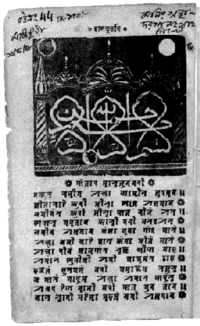Sylheti language
Sylheti[a] (Sylheti Nagri: ꠍꠤꠟꠐꠤ, síloṭi, pronounced [sílɔʈi] ⓘ; Bengali: সিলেটি, sileṭi, pronounced [sileʈi]) is an Indo-Aryan language spoken by an estimated 11 million people, primarily in the Sylhet Division of Bangladesh, Barak Valley of Assam, and northern parts of Tripura in India.[20] The lowlands around Sylhet were originally inhabited by ancient Khasi people (Austroasiatic);[21] and the earliest known Indo-Aryan settlements were made in the 6th century under Kamarupa king.[26][27] Another notable copper plate inscription was found in the village of Paschimbhag in Rajnagar, Moulvibazar that was issued by King Srichandra during the 10th century.[31] A script was developed in the region called Sylheti Nagri, which primarily focused on disseminating Sufi poetry, known as puthi.[33] The literature was transcribed in the standard form of late Middle Bengali, it was similar to the Dobhashi idiom though phonologically was strongly influenced by Sylheti.[34][35] The script was read and taught culturally among households and was not institutionalised,[34] as the Islamic dynasties who ruled over Bengal established Persian alongside Arabic as the official languages.[38] The earliest appearance of a documentation of Sylheti vocabulary was in the Government Report on the History and Statistics of Sylhet District by T. Walton, B.C.S.[40] Despite being annexed to the Assam Province during colonial rule, Sylheti speakers felt a linguistic affinity with the rest of Bengal.[49] BBC News has also broadcast online videos relating to COVID-19 in five major South Asian languages including Sylheti.[55] Recent scholarship notes that these morpho-phonological and mutual intelligibility differences are significant enough that Sylheti could claim itself as a language on its own right."[52] Anecdotal evidence suggests that Sylhetis, who could also speak in Standard Bengali, considered the two languages to be mutually intelligible.[64] On the basis of phonology and phonetics, lexicon, grammatical structure and a lack of mutual intelligibility, some recent linguists claim that Sylheti is not merely a dialectal variation of Bengali but a language in its own right.[56][65][66] Phonologically Sylheti is distinguished from Standard Bengali and other regional varieties by significant deaspiration and spirantisation,[67] leading to major restructuring of the consonant inventory[68] and the development of tones.[74] According to Syed Mostafa Kamal, (approximately 1650 AD) the Baul tradition was founded based on the combination of Chaitanyavad and Jaganmohani ideologies, that mystic literature influenced and seen in the Vaishnava Padavali.[85] Sylheti is also widely spoken in the southern Assam region of Barak Valley, India, which includes the districts of Cachar, Hailakandi and Karimganj.[84] There is also a significant population of Sylheti speakers in Hojai district of Central Assam,[84] Shillong in Meghalaya,[87] and the state of Nagaland.Outside the Indian subcontinent, the largest grouping of Sylheti speakers reside in the United Kingdom, of which 95 percent of British Bangladeshis have origins from the Sylhet region.[89] There are also significant numbers of speakers in the United States, most are concentrated in New York City,[90] and in Hamtramck, Michigan where majority of Bangladeshi Americans there are of Sylheti origin.[99] It is characterised by a loss of breathiness and aspiration contrasts, leading to a significant reduction in its phoneme inventory and to the development of tones.[103][104][105] This is rare among the Indo-Aryan languages, but not unheard of, e.g. in Punjabi, Dogri, Chittagonian, Gawri (Kalam Kohistani), Torwali, some Eastern Bengali varieties, etc.Sylheti continues to have a long history of coexisting with tonal Tibeto-Burman languages including various dialects of Kokborok such as Reang.ꠢꠤꠇꠠꠣꠉꠥ/hikɽa-gu/ꠢꠤꠇꠠꠣꠉꠥꠔꠣhikɽa-gutaꠢꠤꠇꠠꠣꠉꠥ/ ꠢꠤꠇꠠꠣꠉꠥꠔꠣhikɽa-gu/ hikɽa-gutathe studentꠢꠤꠇꠠꠣꠅꠇꠟhikɽa-ôxôlꠢꠤꠇꠠꠣꠅꠇꠟhikɽa-ôxôlthe studentsꠎꠥꠔꠣꠉꠥ/zuta-gu/ꠎꠥꠔꠣꠉꠥꠔꠣzuta-gutaꠎꠥꠔꠣꠉꠥ/ ꠎꠥꠔꠣꠉꠥꠔꠣzuta-gu/ zuta-gutathe shoeꠎꠥꠔꠣꠉꠥꠁꠘ/zuta-guin/ꠎꠥꠔꠣꠉꠦꠍꠤꠘ/zuta-gesin/ꠎꠥꠔꠣꠎꠥꠠꠣzuta-zuŗaꠎꠥꠔꠣꠉꠥꠁꠘ/ ꠎꠥꠔꠣꠉꠦꠍꠤꠘ/ ꠎꠥꠔꠣꠎꠥꠠꠣzuta-guin/ zuta-gesin/ zuta-zuŗathe shoesꠢꠤꠇꠠꠣꠉꠥꠞꠦ/hikɽa-gu-re/ꠢꠤꠇꠠꠣꠉꠥꠔꠣꠞꠦhikɽa-guta-reꠢꠤꠇꠠꠣꠉꠥꠞꠦ/ ꠢꠤꠇꠠꠣꠉꠥꠔꠣꠞꠦhikɽa-gu-re/ hikɽa-guta-re(to) the studentꠢꠤꠇꠠꠣꠅꠇꠟꠞꠦhikɽa-ôxl-ôreꠢꠤꠇꠠꠣꠅꠇꠟꠞꠦ hikɽa-ôxl-ôre(to) the studentsꠎꠥꠔꠣꠉꠥ/zuta-gu/ꠎꠥꠔꠣꠉꠥꠔꠣzuta-gutaꠎꠥꠔꠣꠉꠥ/ ꠎꠥꠔꠣꠉꠥꠔꠣzuta-gu/ zuta-guta(to) the shoeꠎꠥꠔꠣꠉꠥꠁꠘ/zuta-guin/ꠎꠥꠔꠣꠉꠤꠍꠤꠘzuta-gesinꠎꠥꠔꠣꠉꠥꠁꠘ/ ꠎꠥꠔꠣꠉꠤꠍꠤꠘzuta-guin/ zuta-gesin(to) the shoesꠢꠤꠇꠠꠣꠉꠥꠞ/hikɽa-gu-r/ꠢꠤꠇꠠꠣꠉꠥꠔꠣꠞhikɽa-guta-rꠢꠤꠇꠠꠣꠉꠥꠞ/ ꠢꠤꠇꠠꠣꠉꠥꠔꠣꠞhikɽa-gu-r/ hikɽa-guta-rthe student'sꠢꠤꠇꠠꠣꠅꠇꠟꠞhikɽa-ôxl-ôrꠢꠤꠇꠠꠣꠅꠇꠟꠞhikɽa-ôxl-ôrthe students'ꠎꠥꠔꠣꠉꠥꠞ/zuta-gu-r/ꠎꠥꠔꠣꠉꠥꠔꠣꠞzuta-guta-rꠎꠥꠔꠣꠉꠥꠞ/ ꠎꠥꠔꠣꠉꠥꠔꠣꠞzuta-gu-r/ zuta-guta-rthe shoe'sꠎꠥꠔꠣꠉꠥꠁꠘꠔꠞzuta-guint-ôrꠎꠥꠔꠣꠉꠥꠁꠘꠔꠞzuta-guint-ôrthe shoes'ꠎꠥꠔꠣꠉꠥꠔ/zuta-gu-t/ꠎꠥꠔꠣꠉꠥꠔꠣꠔzuta-guta-tꠎꠥꠔꠣꠉꠥꠔ/ ꠎꠥꠔꠣꠉꠥꠔꠣꠔzuta-gu-t/ zuta-guta-ton/in the shoeꠎꠥꠔꠣꠉꠥꠁꠘꠔzuta-guint-ôꠎꠥꠔꠣꠉꠥꠁꠘꠔzuta-guint-ôon/ in the shoesAll of the inflected nouns above have an indefinite article preceding their case markers.The genitive ending is also applied to verbs (in their verbal noun forms), which is most commonly seen when using postpositions (for example: ꠢꠤꠇꠘꠞ ꠟꠣꠉꠤ hiknôr lagi, 'for learning').These are typically represented by adding the negative particle ꠘꠣꠄ (nae) to indefinite pronouns, which are themselves derived from their corresponding question words.The same sample subject pronouns will be used for all the example conjugation paradigms: mui (ꠝꠥꠁ), ami (ꠀꠝꠤ), tui (ꠔꠥꠁ), tumi (ꠔꠥꠝꠤ), he (ꠢꠦ), tai (ꠔꠣꠁ) and afne (ꠀꠙꠘꠦ).

Sylheti NagriBangladeshSylhet DivisionBarak ValleySylhetisLanguage familyIndo-EuropeanIndo-IranianIndo-AryanEasternBengali–AssameseMagadhi PrakritMāgadhanApabhraṃśaAbahaṭṭhaWriting systemSylheti Nāgarī scriptBengali–Assamese scriptLatin scriptISO 639-3Linguist ListGlottologLinguasphereAtlas of the World's Languages in DangerUnicodeIndic textquestion marks or boxesBengaliIndo-Aryan languageTripuraMeghalayaManipurNagalanddiasporaUnited KingdomUnited StatesCanadaMiddle Eastdialect of Bengalidiglossicvernacularstandard Bengalicodified lectlanguage shiftNames of SylhetSylhetKhasi peopleKamarupaRajnagarMoulvibazarSrichandraConquest of SylhetPersianArabicDobhashiAssam ProvinceBengali literatureHason RajaShah Abdul Karimreferendum in 1947minoritiseddiglossiaregional dialectsofficial languageAssameseBBC NewsCOVID-19South Asian languagesVangiyasadhu bhashaChittagonianmutual intelligibilityEthnologueBengali–Assamese languagesHajongdialectother regional varietiesTower HamletsSadeq AliShah JalalShri ChaitanyaVaishnava PadavaliRadha RamanIslamic historytatsamamedium of instructionNew TestamentSylhet Nagri scriptSunamganjHabiganjCacharHailakandiKarimganjJiribamHojai districtShillongKolkataIndian subcontinentBritish Bangladeshiseast LondonNew York CityHamtramck, MichiganBangladeshi AmericansTorontolexical similarityStandard Rarhi Bengalitypical Bangladeshi Standarddevelopment of tonesCentralClose-midOpen-midLabialDentalRetroflexAlveolarPalato-alveolarGlottalPlosiveAffricateFricativeApproximantIndo-Aryan languagesPunjabiTorwaliEastern BengaliTibeto-Burman languages